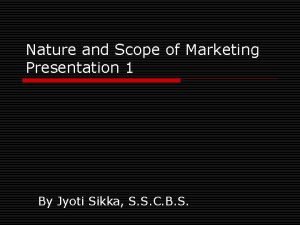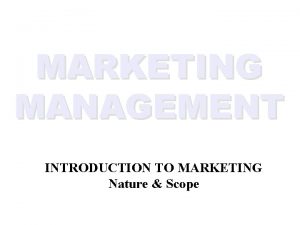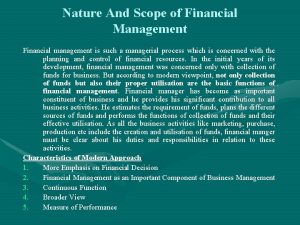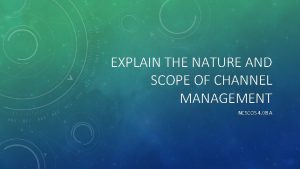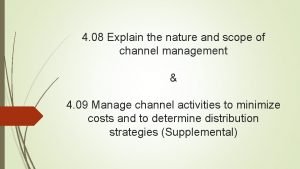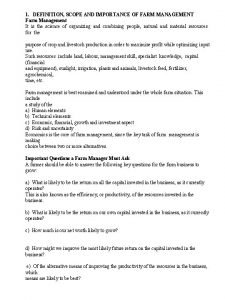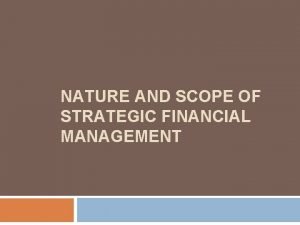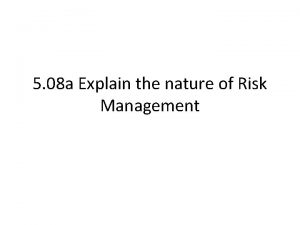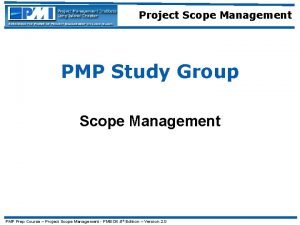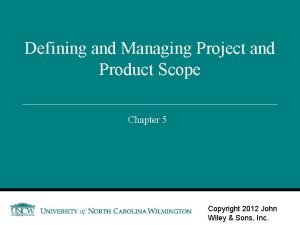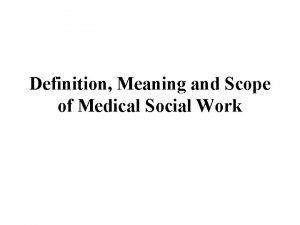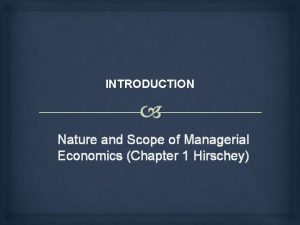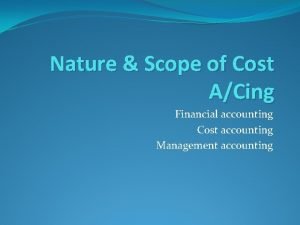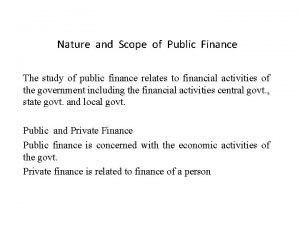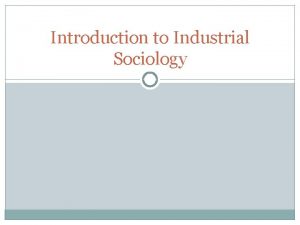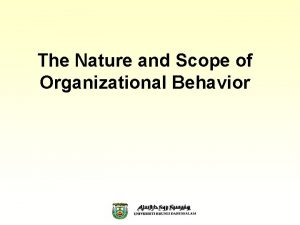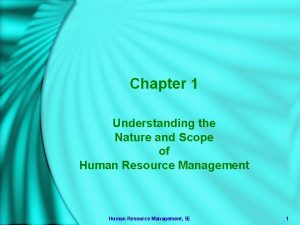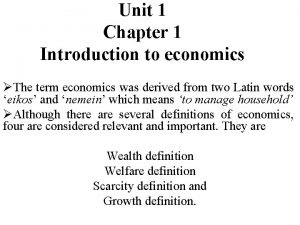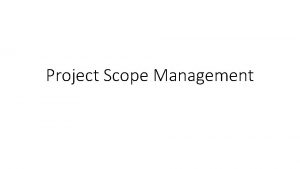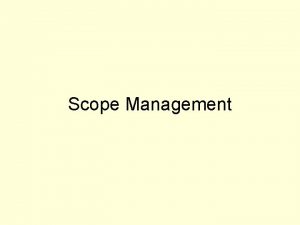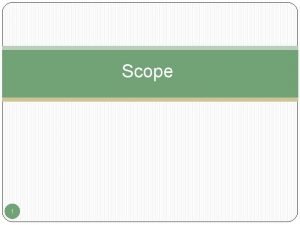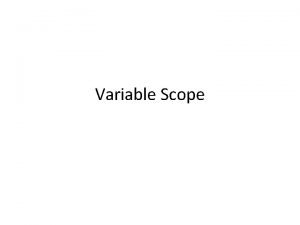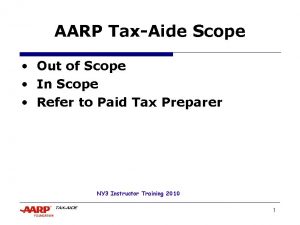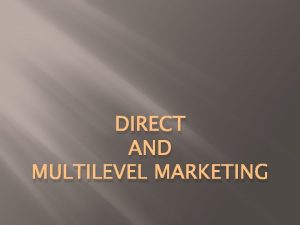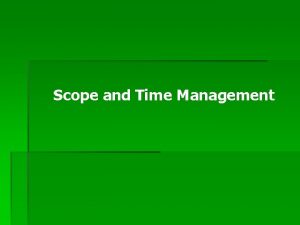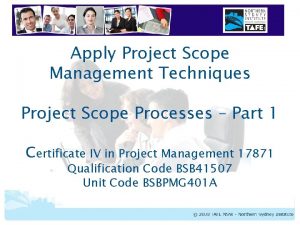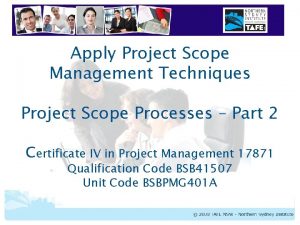MARKETING MANAGEMENT INTRODUCTION TO MARKETING Nature Scope WHAT






























- Slides: 30

MARKETING MANAGEMENT INTRODUCTION TO MARKETING Nature & Scope

WHAT IS MARKET? The term 'market' originated from Latin word 'marcatus' having a verb 'mercari' implying 'merchandise' 'ware traffic' or 'a place where business is conducted'. For a layman, the word 'market' stands for a place where goods and persons are physically present. 'fish market', 'mutton market', 'meat market', 'vegetable market', 'fruit market', 'grain market'. For him, it is a congregation of buyers and sellers to transact a deal. However, for us as the students of marketing, it means much more. In a broader sense, it is the whole of any region in which buyers and sellers are brought into contact with one another and by means of which the prices of the goods tend to be equalised easily and quickly.

DEFINITIONS According to Professor Jevons: "Market means any body of persons who are in intimate business relations and carry on extensive transactions in any commodity". In the words of Mr. Pyle: "Market includes both place and region in which buyers and sellers are in free competition with one another'.

CLASSIFICATION OF MARKETS Markets 'can be classified on different bases of which most common bases are: a) b) c) d) e) f) g) h) AREA TIME TRANSACTIONS REGULATION VOLUME OF BUSINESS NATURE OF GOODS NATURE OF COMPETITION DEMAND SUPPLY CONDITIONS

A. On the Basis of Area : Perishable and semi-perishable goods like fish, flowers, vegetable, eggs, milk, and others. Regional markets covers a wider area - may be a district, a state or inter-state dealing in durables both consumer and non durables and industrial products, including agricultural produce. National markets the area covered is national boundaries - dealing in durable and non-durable consumer goods, industrial goods, metals, forest products, agricultural produce. World or international market, the movement of goods is widespread throughout the world making it as a single market. It should be noted that due to the latest technologies in transport, storage and packaging, even the most perishable goods are sold all over the world, not that only durables.

B. On the basis of Time : There can be short period and long period markets. Short-period markets are for highly perishable goods of all kinds and long-period markets are for durable goods of different varieties-may be produced or manufactured. C. On the basis of Transactions : Taking the nature of transactions, these can be 'spot' and 'future' markets. In 'spot' market once the transaction takes place the delivery takes place, While in case of future markets, transactions are finalised pending delivery and payment for future dates.

D. On the basis of Regulation: Taking regulation, markets can be regulated and non-regulated. A 'regulated market' is one in which business dealings take place as per set rules and regulations regarding, quality, price, source changes and so on. Like Agricultural products or produce and securities. Unregulated market is a free market where there are no rules and regulations; even if they are there, they are amended as per the requirements of parties of exchange. E. On the Basis of Volume of Business : "Wholesale" and "Retail". ‘Wholesale’ markets are featured by large volume business and wholesalers. ‘Retail' markets are those where quantity bought and sold is on small-scale. The dealers are retailers who buy from wholesalers and sell back to consumers.

F. On the basis of Nature of Goods: Taking the nature of goods, there can be commodity markets, capital markets. 'Commodity' markets deal in favour of material, produce, manufactured goods may be consumer and industrial and bullion market dealing precious metals. 'Capital' market is a market for finance. These markets can be subdivided into 'money' market dealing lending, and borrowing of money; 'Securities' market or 'stock' market dealing in buying and selling of shares and debentures and 'foreign exchange' market where it is a forex market dealing buying and selling of foreign currencies - may be hard or soft.

G. On the basis of Nature of Competition: Based on competition or competitive forces, there can be variety of markets for a product or service. However, only two are the most important namely, perfect and imperfect. A 'perfect' market is one which is characterised by (a) Large number of buyers and sellers (b) Prevalence of single lowest price for products that are 'homogeneous' (c) The perfect knowledge on the part of buyers and sellers (d) Free entry and exist of firms in market. These types for markets exist hardly. The other one is 'imperfect' which is featured by (a) Products may be similar but not identical (b) Different prices for a class of goods (c) Existence of physical and psychological barriers on movement of goods (d) No perfect knowledge of products and other dimensions on the part of buyers and sellers.

H. On the basis of Demand Supply: Based on demand supply conditions or hold of buyers and sellers, there can be seller's ' and buyer's markets. A seller's market is one where sellers are in driver's seat and the buyers are at the receiving end. where demand for goods exceeds supply. Buyer's market is one where buyers are in commanding position. supply is exceeding the demand for the goods.

What is Marketing? Goods and services do not move automatically from the makers to the users. There is a definite mechanism that brings about exchange of goods and services against money or money's worth for the mutual benefit-namely, satisfaction to the consumers and surplus to the producers and manufacturers. Marketing is the belt that connects the two major wheels of any economy namely, producers and consumers. Marketing is the creation of utilities as goods and services get value added by the time they reach the consumers.

DEFINITIONS In economic jargon "marketing" refers to "all the activities involved in the creation of place, time, possession and awareness utilities". Professor Glasser says : "Marketing in a free economy is the skill of selecting and fulfilling consumer desires so as to maximise the profitability per unit of capital employed in the enterprise". In the words of Professors Cundiff and Still : "Marketing is the business process by which products are matched with market and through which transfers of ownership are effected". Theodore Levitt Says "Marketing is getting and keeping the customer'.

According to Harry L. Hansen : "Marketing is the process of discove 1 ing and translating consumer needs and wants into product and se 1 vice specifications, creating demand for these products and se 1 vices and then, in nun, expanding the demand". Professor Philip Kotler has defined marketing: "Marketing is a social and managerial process by which individuals and groups obtain what they need and want through creating exchanging if products and value with others".

NATURE OF MARKETING The characteristics speak of the very nature of marketing. These are : • It is Operational • It is Customer Oriented • It is Mutuality of Benefits • It is Value Driven • It is Proactive to the Environment • It Covers Both Profit and Non-Profit Making Organisations

It is Operational: That is, managers must think and act to achieve results. Benefits of marketing will not emerge from a passive attitude to the exchange process emphasizing the statement "no gains without pains". It is Customer Oriented: That is, marketing firm is to be the keen observer focussing its attention on needs of customers. Its effectiveness lies in finding solutions to the challenges posed by these demands. It is Mutuality of Benefits: Exchange of goods and services work and persist because it is the mutual interest of both parties to continue. Both the marketer and customer benefit through supply of quality goods and services in return for profit. Here, customer's benefits exceed costs. It is Value Driven: I The culture of the marketing firm are based on a desire to build the business through meeting the needs and responding to the market where the values espoused by firm's leaders are communicated to all those involved in the firm. It is Proactive to the Environment: Marketing firm is a sub-system of super-system, the environment. The environment is something which is external to the firm. The environmental forces are ecology, technology, competition, physical resources, legal-frame work, socioeconomic factors, which are to be accepted by the marketing unit where it is to be proactive and not reactive.

It Covers Both Profit and Non-Profit Making Organisations: Marketing is not confined to only profit making organisations but covers non-profit making organisations or charitable institutions that sell services such as educational institutions, churches, temples, mosques, gurudwaras, hospitals, sports clubs and so on.

DISTINCTION BETWEEN "MARKET" AND "MARKETING" The distinction between "Market" and "Marketing" can be drawn clearly on following grounds: 1. System Versus Activity 2. Outlet Versus Means 3. Narrow Versus Comprehensive Concept 4. Occurrence of Event 5. Change Versus Consistency

System Versus Activity "Market" is a system or an atmosphere or a mechanism that facilitates such forces as are leading to price fixation. That is, physical presence of goods or men at a place is not essential condition of a highly developed and elastic market. “Marketing” is the sum-total of all those activities that are related to the free-flow of goods from points of production to the points of consumption. Physical movement of goods is the hall-mark of marketing; that is, once the price fixation is done, the journey starts from sellers to buyers. Outlet Versus Means ‘Market’ is a solid foundation to push goods from sellers to buyers. It, is an outlet to let out the products. It is the key to engine of marketing. ‘Marketing’ is a gigantic (large) machinery to move the goods by creating utilities of place, time and ownership.

Narrow Versus Comprehensive Concept ‘Market’ as a concept has a narrower meaning and coverage. It signifies both place and an atmosphere where buyers and sellers are in touch with one another. ‘Marketing’ is a wider or comprehensive term that represents the entire process of distribution and the process prior to distribution. Occurrence of Event The question is whether 'market' comes first or marketing. 'Market' acts as a price-fixing mechanism and once the transactions are struck, then the actual movement of goods starts and change in ownership is brought about. That is, 'market' is the, starting point and marketing comes thereafter. Change Versus Consistency 'Market’ it might undergo a change in marketing that in buyers and sellers, their requirements, with changes in supply and demand dimensions. These changes are comparatively quicker. ‘Marketing” in terms of philosophy - it remains more constant, it takes decades to change as warranted by environmental external factors. Thus, change in market is much faster than change in case of marketing philosophy or concept.

DIFFERENCE BETWEEN "MARKETING" AND "SELLING" There are good many people who use the words 'marketing' and 'selling' interchangeably. Infact, there is difference between the two terms so much so that their real meaning and content make them altogether quite distinct words. The basic difference can be outlined as under: 1. SCOPE 2. EMPHASIS 3. OCCURRENCE 4. PHILOSOPHY

• Scope: 'Marketing' involves the design of product acceptable to customers and transfer of ownership between the sellers and buyers. 'Selling' simply involves obtaining orders from customers and supplying them the products. It is more concerned with the sale of goods already produced. • Emphasis: ‘Marketing’, the focus is on satisfying the wants of customers ‘Selling’ emphasizes the need of the seller to convert products into cash. Marketing is customer-oriented and seeks to earn profits through customer satisfaction. Selling is product-oriented and seeks to increase the sales volume. 3. Occurrence: ‘Marketing’ begins much before the production of goods and services. It continues even after the sale because, 'after-sale services' may be necessary for satisfying the wants of customers. ‘Selling’ comes after the production has been completed and it comes around with the delivery of the product to the customer. In other words, marketing begins before the manufacturing cycle, whereas selling comes at the end of this cycle. 4. Philosophy: ‘Marketing’ has philosophical and strategic implications. It is directed towards the long-term objectives of growth and stability. ‘Selling’ is mere tactical routine activity with a short-term perspective, under which customers are taken for granted as one homogeneous unit.

S. No. MARKETING SELLING 1 Focusses on Customers needs Focusses on Sellers needs 2 Begins before Production Begins after Production 3 Continues after Sale Comes to an end with Sale 4 A Comprehensive Term in terms of Meaning A Narrow Term in terms of Meaning 5 Philosophy of Business Routine day to day Physical Process 6 Profits through Customer Profits through Sales Volume Satisfaction 7 Let the Seller be aware Let the Buyer be· aware 8 Integrated Approach Fragmented Approach 9 Long-term Perspective Short-term Perspective 10 Customer first then Product first then Customer

SCOPE OF MARKETING Marketing itself is the greatest task of creating, promoting and delivering goods and services to final consumers and business buyers. In fact, marketing people are involved in marketing of ten types of entities namely, 1. Goods 2. Services 3. Experiences 4. Events 5. Persons 6. Places 7. Properties 8. Organizations 9. Information 10. Ideas

Let us note these in brief which will help us in knowing the real gamut of tasks of marketing. 1. GOODS Goods - tangible - constitute the bulk of a country's production and marketing effort. Advanced country namely, America produces and markets 80 million eggs, 3 billion chickens, 5 million hair-dryers, 200 million tons of steel, 4 billion tons of cotton 2 billion tons of ground nuts, 1. 5 billion maize. As against this, country like India - a developing one, produces 25 billion eggs, 0. 25 billion chicken, 90 million tons of steel, 1 billion tons of cotton 0. 75 billion tons of ground nuts 0. 25 billion maize-to take a few cases. The major items of goods in case of developing nations are those relating to basic necessities such as food, shelter, clothing and other basic commodities while the luxury items of high-class society needs are the needs of developed countries.

2. Services With the advancement of the economies, the growing proportion of their economic activities are more based towards services. The ratio of service to good ranges between 65 to 35 to 70 to 30 percentages to the total. In growing economies, it is growing at lower pace and the ratio ranges between 25: 75 and 35: 65 percentage. These services can be broadly classed as economic and noneconomic, personal and group, financial and non- financial. They are in a variety of services of unskilled to highly professionalised services. Market offerings consist of service and product mix in wider and varying range. 3. Experiences One can create, stage and market experiences by orchestrating. U. S. A's Walt Disney, World's Magic Kingdom is a unique experience climbing of Mount Everest, visiting. a fairy kingdom, a pirate ship or a haunted house, hiking, trekking ESSELL world, Water Kingdom, Spending a week at base ball camp or spending a fortnight in meditation centres and so on.

4. Events Creative marketers promote time based events such as Olympics, trade-shows, sport events, company anniversaries, artistic performances; holding fashion shows; all these need good planning by professionals to see that events are a grand success. Musical concerts etc 5. Persons Celebrity marketing has become a major growing business. In the past, a, person seeking name and fame or image used to hire a press to write and publish stories in news papers and magzines. Today, each professional has an agent or a personal secretary be it a lawyer, doctor, actor or actress, financiers, CEOS, musician, magicians. In world of American art Andy Warhol has applied entrepreneurial marketing principles to build his own fame. Indian case, Amitab Bachchan made a come-back in a big way through KBC Mr. Tom Peter a great management consultant is the master of self-branding and asked each person to build a brand of his own.

5. Persons: Celebrity marketing has become a major growing business. In the past, a, person seeking name and fame or image used to hire a press to write and publish stories in news papers and magazines. Today, each professional has an agent or a personal secretary be it a lawyer, doctor, actor or actress, financiers, CEOS, musician, magicians. In world of American art Andy Warhol has applied entrepreneurial marketing principles to build his own fame. Indian case, Amitab Bachchan made a come-back in a big way through KBC Mr. Tom Peter a great management consultant is the master of self-branding and asked each person to build a brand of his own. 6. Places: Places - may be cities, states, regions and even the whole country are competing in attracting tourists, industrialists, employees, professionals, investors, factories, head offices, new residents. Ireland is a place marketer has attracted more than 500 companies to locate their plants, operating Irish Development Board, the Irish tourist Board, the Irish Export Board, attracting foreign investment, tourists, professionals and importers. Place marketers include economic development specialists, real-estate agents, commercial banks, local business associations and public-relations agencies.

7. Properties: Properties represent intangible rights of ownership of either real property - real estate or financial property - stocks and bonds. These properties are bought and sold which warrant a marketing effort. It is our common experience that real estate agents work for sellers and buyers linking them, stock brokers bring together buyers and sellers of stocks and bonds. These intermediaries may be individuals or institutions. 8. Organisations: Organisations like individuals work hard to build their image or personality in the minds of public- through public-relations techniques. Institutional ads by companies speak of this. Philips company-the Dutch electronic company-uses the words "Let's Make Things Better" Coca Cola Company has a slogan "Things go Better with Coca Cola. " BPL says "Believe in the Best. " Pepsi Cola company says "Want More. " Sony corporation says only "It is a sony". Even universities, Educational Institutions, Museums, Performing Art Units have their plans to boost their image to compete for more students, participants, audiences, visitors on one side, and funds on the other.

9. Information: Information is a valuable product which can be produced and sold. Schools, colleges and universities and other institutions of learning produce and distribute at a price the product to students, parents and the communities. Encyclopedias and non- fiction publications are rich source of information. Periodicals and journals provide highly specialised and updated information. 10. Ideas: Each market offering has a basic idea which forms its core or heart. The president of Japan Life says, "We manufacture beds ranging Rs. 80, 000 to 1, 25, 000 but sell health. " Mr. Charley Reveson of famous Revelon-Cosmetics Company observed. " "In the factory, we make cosmetics; in the store we sell hope. " In this sense, buyer of a drill is buying a hole; purchaser of a spectacles an eye sight. That is, products and services are the platforms for delivering the ideas or benefits.

 Nature and scope of marketing management
Nature and scope of marketing management What is marketing nature scope and importance
What is marketing nature scope and importance Explain the nature and scope of marketing
Explain the nature and scope of marketing Financial management nature
Financial management nature Scope of channel management
Scope of channel management Explain the nature and scope of distribution
Explain the nature and scope of distribution Farm management scope
Farm management scope Strategic financial management outlook is what in nature
Strategic financial management outlook is what in nature Accounting scope and objectives
Accounting scope and objectives Nature of risk meaning
Nature of risk meaning Nature of risk meaning
Nature of risk meaning Process scope definition
Process scope definition Use case diagram
Use case diagram Nature and scope of physics
Nature and scope of physics Explain scope of education
Explain scope of education Managerial economics chapter 1
Managerial economics chapter 1 Social worker medical definition
Social worker medical definition Nature and scope of clinical psychology
Nature and scope of clinical psychology Nature and scope of public administration
Nature and scope of public administration Managerial economics nature and scope
Managerial economics nature and scope Nature of cost accounting
Nature of cost accounting Nature of public
Nature of public Nature of industrial sociology
Nature of industrial sociology Multidisciplinary nature of environmental science
Multidisciplinary nature of environmental science Scope of organizational behaviour
Scope of organizational behaviour What is the scope of hrm
What is the scope of hrm Nature and scope of physics
Nature and scope of physics Adam smith definition of economics
Adam smith definition of economics Nature of educational sociology
Nature of educational sociology Applied psychology vs psychology
Applied psychology vs psychology Nature and nature's laws lay hid in night meaning
Nature and nature's laws lay hid in night meaning
